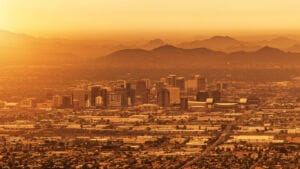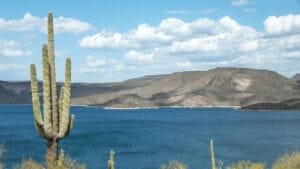Once an ugly swath of usually dry land that often served as a dumping ground, Rio Salado today offers the best of both worlds — economic development opportunities and a riparian haven for environmentalists.
Options for education and entertainment round out the dream planners had 40 years ago for the Salt River as it winds through Tempe and Phoenix. Tempe Town Lake, a two-mile stretch of sky-blue water that anchors the eastern section of Rio Salado, marks its 10th anniversary on Dec. 12. Meanwhile, in Phoenix the Nina Mason Pulliam Rio Salado Audubon Center, an 8,000-square-foot education facility, opened in October.
Ask Steve Nielsen, who was Tempe’s Rio Salado project manager for more than 13 years, if it has reached its potential, and he replies without hesitation: “Absolutely.”
But he concedes: “With current economic conditions, development around the lake hasn’t progressed as quickly as we had envisioned. At the same time, Rio Salado was the least valuable property in all of Tempe, and now it is the most valuable.”
Nielsen, currently assistant vice president of university real estate development at Arizona State University, says the primary objectives of Rio Salado were flood control, economic sustainability for Tempe and environmental enhancement.
“From that perspective, we achieved every one of those,” he says.
What’s more, Tempe established wildlife habitat areas upstream and downstream from the lake. In Phoenix, at 3131 S. Central Ave. on the south bank of the Salt River, sits the National Audubon Society’s first education center in Arizona. Sam Campana, vice president and executive director of Audubon Arizona, calls the learning facility a centerpiece for Phoenix’s Rio Salado Habitat Restoration Project.
“Birds are the main attraction, but children also learn science, geology and history here,” Campana says.
The five-mile stretch of Rio Salado in Phoenix also features more than 20 miles of hiking and biking trails. Yet, with all that Rio Salado offers, and with 35 schools within five miles of the center, there is a sense that this inner-city paradise is underutilized.
Rio Salado Beyond the Banks is an advisory committee to the city of Phoenix that has a vision of maximizing the long-term educational, recreational and economic benefits of the river to the community. But George Young, an active member of the committee, says, “It’s a very slow work in progress, frustrating at times. The city has budget problems, and that’s kind of thrown a wrench into a lot of our ambitions, especially as far as the promotion of Rio Salado goes.”
Chris Parks, Rio Salado Habitat supervisor for the city of Phoenix, says plans call for restoring the river bottom from 26th Street to 19th Avenue, with trails, equestrian paths and restaurants along the way. Eventually, the city hopes to establish a sense of connectivity with Tempe Town Lake for the public, as well as animals and birds.
Tempe Mayor Hugh Hallman says development around Tempe Town Lake stalled around 1999 and 2000, but picked up in 2004 after services provided by the city’s development department were streamlined to help developers and local residents avoid costly delays. Today, virtually all development around the lake occurred since 2004, and that includes 18 months of the worst economic downturn since the Great Depression.
Tempe Town Lake, along with projects on Mill Avenue and Apache Boulevard, offers developers various paths to success, Hallman says. Tempe, he adds, is well positioned for economic recovery.
“The lake is part of that picture,” he says.
SunCor Development Company, which is developing the Hayden Ferry Lakeside project at Tempe Town Lake, occupies 40,000 square feet in one of the towers. Thus far, SunCor has erected six structures with more than 1 million square feet — two office towers, a loft office building, two condo high rises with a total of 150 units, and a garage. The overall urban infill project encompasses 43 acres from bridge to bridge on Mill Avenue to Rural Road. Nine more towers, more commercial than residential, are planned and will add 4 million square feet of space to the project. Steve Betts, president and CEO of SunCor, says it will take seven to 10 years to complete the project.
“We always thought Hayden Ferry Lakeside was a multicycle project, with ebbs and flows through several up and down cycles,” Betts says.
He expects the project to be one of the first to come back when the economy improves.
“It is literally the geographic center of the Valley surrounded by three freeways, it’s on the light rail, it’s five minutes from the airport,” Betts says, “and you have the only urban lake at your doorstep.”



